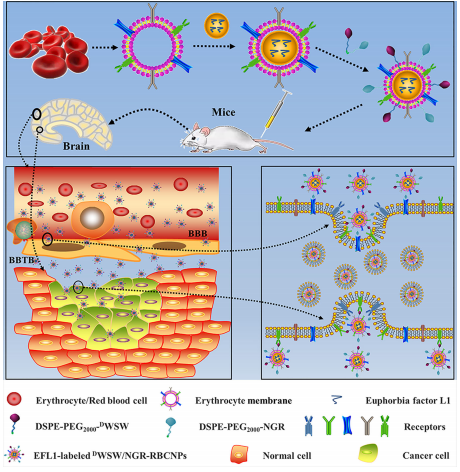文献:Dual-Target Peptide-Modified Erythrocyte Membrane-Enveloped PLGA Nanoparticles for the Treatment of Glioma
文献链接:https://pubmed.ncbi.nlm.nih.gov/33194638/
作者:Yuexin Cui , Jiejie Sun , Wenyan Hao , Mengyu Chen, Yingzi Wang, Fenghua Xu and Chunsheng Gao
相关产品:DSPE-PEG-Mal 磷脂-聚乙二醇-马来亚酰胺
原文摘要:Penetration of the blood–brain barrier (BBB) and the blood–brain tumor barrier (BBTB) remains a significant challenge for the delivery of drugs in the treatment of glioma.
Therefore, the development of targeted preparations with the ability to penetrate the BBB and BBTB, and target gliomas, is an important approach if we are to improve the efficacy of glioma treatment. In the current study, an active targeting preparation based on PLGA nanoparticles coated with erythrocyte membranes (RBCNPs) and dual-modified with DWSW and NGR peptide ligands (DWSW/NGR-RBCNPs). Euphorbia factor L1 (EFL1) extracted from euphorbiae semen was used as the model drug. The final nanoparticles were characterized by in vivo and in vitro tests. In vitro results showed that EFL1-loaded DWSW/NGR-RBCNPs were taken up by cells and had the ability to penetrate the BBB and BBTB and produce cytotoxic effects. Furthermore, in vivo studies
in mice showed that when injected intravenously, these specialized NPs could enter the brain, target tumor tissue, and significantly extend life span. The results showed that dualtargeting EFL1-loaded DWSW/NGR-RBCNPs have significant potential as a nanotherapeutic tool for the treatment of brain glioma.
DSPE-PEG2000-Mal由三部分组成。DSPE为分子提供了亲脂性;聚乙二醇具有良好的亲水性和柔韧性,能增加整个分子的水溶性和稳定性,减少immunity原性;马来酰亚胺(Mal)是一种反应性基团,可与含有巯基(-SH)的分子发生特异性的迈克尔加成反应。可用于制备聚乙二醇化脂质体或胶束,作为化合物递送系统的载体,提高化合物的溶解度、延长循环半衰期、减少非特异性蛋白质结合或细胞粘附。通过马来酰亚胺基团与生物分子如抗体、多肽、蛋白质等的巯基反应,实现对这些生物分子的标记、修饰或靶向连接,在靶向化合物递送、生物成像、蛋白质组学等研究中具有作用。该文献基于此研究一种PLGA纳米颗粒包裹红细胞膜(RBCNPs)和DWSW和NGR肽配体双修饰(DWSW/NGR-RBCNPs)的活性靶向制剂。
图:用红细胞膜包膜PLGA纳米颗粒修饰双靶肽Glioma的双靶肽示意图
制备过程:
将DSPE-PEG2000-Mal加入PBS(pH 7.4),缓慢加入DWSW或NGR(1:1摩尔比)溶液(PBS,pH 7.4)中,搅拌同时搅拌小时。然后用蒸馏水(MWCO 3.0kDa).最后的溶液被冻干,等待进一步使用。收集红细胞膜。
PLGA纳米颗粒的制备
在丙酮中分别加入 PLGA和EFL1或Cy5.5(疏水探针)。一旦完全溶解,将混合物慢慢倒入的水中。然后,将混合物在露天搅拌,以消除有机溶剂;所得产物为装载efl1的NPs或Cy5.5-labelled NPs。
多肽修饰RBCNPs的制备
红细胞膜在浴超声器使用微型挤出机通过挤压400纳米和200纳米聚碳酸酯多孔膜反复分离红细胞膜囊。为了制备非修饰的rbcnPs(N-RBCNPs),efl1标记的NPs或Cy5.5-loaded NPs与红细胞膜囊泡(以3:1的比例)混合,然后通过聚碳酸酯膜挤压;该过程创建了装载EFL1的RBCNPs或Cy5.5-labelled RBCNPs。DWSW修饰的RBCNPs(DWSW-RBCNPs),采用脂质插入技术制备了NGR修饰的RBCNPs(NGR-RBCNPs)和DWSW/NGR修饰的RBCNPs(DWSW/NGR-RBCNPs)。将DSPE-PEG2000- DWSW(4%,DSPE-PEG2000- DWSW与NPs的重量比)或DSPEPEG2000-NGR(3%,重量比)加入到PBS(pH 7.4)中的RBCNPs中,搅拌。为了制备DWSW/NGR-RBCNPs,在溶液中同时加入了DSPEPEG2000- DWSW和DSPE-PEG2000-NGR。

图:显示核壳结构的纳米颗粒
结论:DSPE-PEG2000-Mal,NGR和DWSW参与制备的DWSW/NGR-RBCNPs具有仿生结构和双靶向能力。DWSW/NGR-RBCNPs首先能够穿透BBB和BBTB,然后靶向有害细胞。efl1负载DWSW/NGR-RBCNPs提高了效果。结果表明,NGR和DWSW是纳米给药系统修饰的有效配体。

 2025-02-14 作者:ZJ 来源:
2025-02-14 作者:ZJ 来源:

